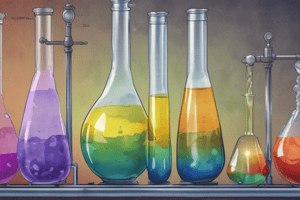Podcast
Questions and Answers
What does a pH of 7 represent on the pH scale?
What does a pH of 7 represent on the pH scale?
- Highly basic
- Moderately basic
- Neutral solution (correct)
- Highly acidic
Which characteristic is commonly associated with acids?
Which characteristic is commonly associated with acids?
- Bitter taste
- Turn blue litmus paper red (correct)
- Form hydrogen gas when reacting with metals
- Release OH⁻ ions
How are strong acids different from weak acids?
How are strong acids different from weak acids?
- Strong acids have a lower pH value
- Strong acids have a less sour taste
- Weak acids completely dissociate into H⁺ ions
- Weak acids partially dissociate into H⁺ ions (correct)
What happens during a neutralization reaction between an acid and a base?
What happens during a neutralization reaction between an acid and a base?
Which ion concentration increases as the pH decreases?
Which ion concentration increases as the pH decreases?
What is a common property of bases?
What is a common property of bases?
Which theory defines acids as proton donors and bases as proton acceptors?
Which theory defines acids as proton donors and bases as proton acceptors?
What color does blue litmus paper turn when it comes in contact with a base?
What color does blue litmus paper turn when it comes in contact with a base?
Which substance is considered a base according to the Arrhenius theory?
Which substance is considered a base according to the Arrhenius theory?
What is the product of the reaction between hydrochloric acid and sodium hydroxide?
What is the product of the reaction between hydrochloric acid and sodium hydroxide?
Which characteristic is common to all bases?
Which characteristic is common to all bases?
Which theory of acids and bases is limited to weak acids and weak bases?
Which theory of acids and bases is limited to weak acids and weak bases?
Flashcards are hidden until you start studying
Study Notes
Acid and Base Fundamentals
Understanding the concepts of acids and bases is crucial for a variety of scientific fields, including chemistry, biology, and environmental science. In this exploration, we'll delve into the basics of acids and bases, starting with the pH scale, key characteristics, neutralization reactions, and the theories that help us comprehend these fundamental chemical concepts.
pH Scale
The pH scale is a logarithmic measure of hydrogen ion (H⁺) concentration in a solution. It spans from 0 (highly acidic) to 14 (highly basic) with a pH of 7 representing a neutral solution. A lower pH indicates a higher concentration of H⁺ ions while a higher pH indicates a lower concentration of H⁺ ions.
Acid Characteristics
Acids are substances that release H⁺ ions (protons) into a solution upon dissolution. In general, acids have a sour taste and turn red litmus paper blue. Common acids include hydrochloric acid (HCl), sulfuric acid (H₂SO₄), and citric acid (C₆H₈O₇). Acids can be classified into strong and weak acids based on their ability to completely dissociate into H⁺ ions.
Neutralization Reactions
Neutralization occurs when an acid reacts with a base, forming a salt and water. The general equation for a neutralization reaction is:
[ \text{acid} + \text{base} \rightarrow \text{salt} + \text{water} ]
A common example of a neutralization reaction is the mixing of hydrochloric acid (HCl) and sodium hydroxide (NaOH), producing sodium chloride (NaCl) and water (H₂O).
Base Characteristics
Bases are substances that release hydroxide ions (OH⁻) into a solution upon dissolution. Bases have a slippery feeling when wet and turn blue litmus paper red. Common bases include sodium hydroxide (NaOH), calcium hydroxide (Ca(OH)₂), and ammonia (NH₃). Bases can be classified into strong and weak bases based on their ability to completely dissociate into OH⁻ ions.
Acid-Base Theories
Several theories have been proposed to explain the behavior of acids and bases. Two of the most widely accepted theories are the Arrhenius theory and the Brønsted-Lowry theory.
The Arrhenius theory, proposed by Svante Arrhenius, defines acids as substances that release H⁺ ions and bases as substances that release OH⁻ ions. This theory is limited to weak acids and weak bases, as strong acids and bases completely dissociate in solution, and their behavior does not follow the Arrhenius definition.
The Brønsted-Lowry theory, proposed by Johannes Brønsted and Thomas Lowry, defines acids as proton donors and bases as proton acceptors. According to this theory, any substance that gains a proton is considered a base, and any substance that loses a proton is considered an acid. This theory is more general and encompasses both weak and strong acids and bases.
In conclusion, understanding the fundamental concepts of acids and bases is essential in various scientific fields. The pH scale, acid and base characteristics, neutralization reactions, and acid-base theories are all important components of the subject. By exploring these key ideas, we can gain a deeper understanding of the chemical world around us.
Studying That Suits You
Use AI to generate personalized quizzes and flashcards to suit your learning preferences.




